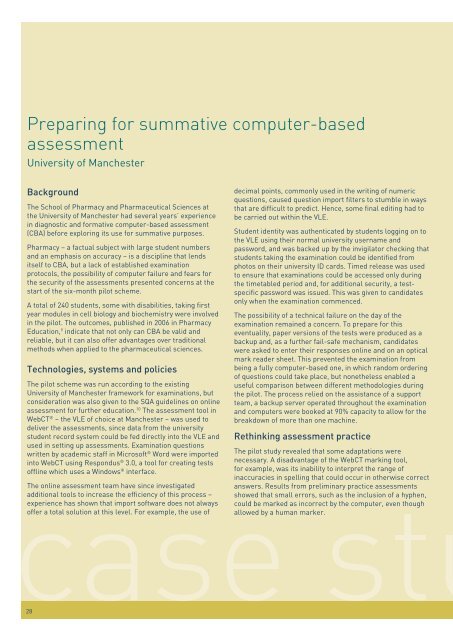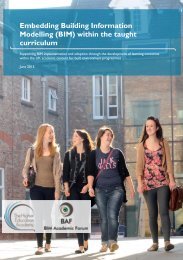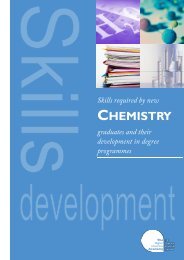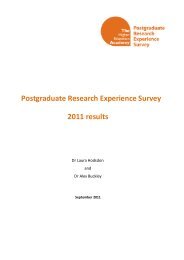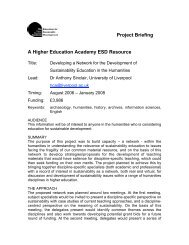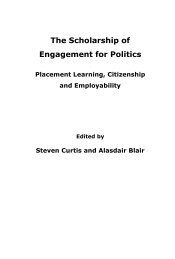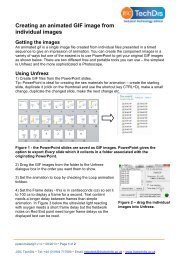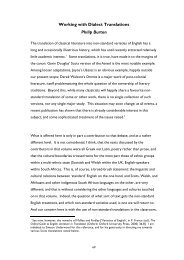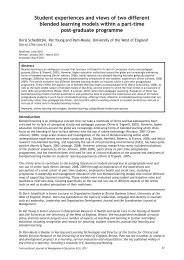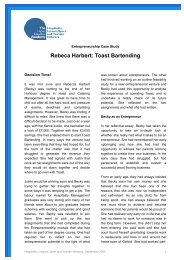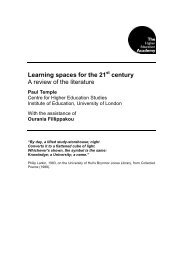Effective Practice with e-Assessment: An overview of ... - Jisc
Effective Practice with e-Assessment: An overview of ... - Jisc
Effective Practice with e-Assessment: An overview of ... - Jisc
You also want an ePaper? Increase the reach of your titles
YUMPU automatically turns print PDFs into web optimized ePapers that Google loves.
Preparing for summative computer-based<br />
assessment<br />
University <strong>of</strong> Manchester<br />
Background<br />
The School <strong>of</strong> Pharmacy and Pharmaceutical Sciences at<br />
the University <strong>of</strong> Manchester had several years’ experience<br />
in diagnostic and formative computer-based assessment<br />
(CBA) before exploring its use for summative purposes.<br />
Pharmacy – a factual subject <strong>with</strong> large student numbers<br />
and an emphasis on accuracy – is a discipline that lends<br />
itself to CBA, but a lack <strong>of</strong> established examination<br />
protocols, the possibility <strong>of</strong> computer failure and fears for<br />
the security <strong>of</strong> the assessments presented concerns at the<br />
start <strong>of</strong> the six-month pilot scheme.<br />
A total <strong>of</strong> 240 students, some <strong>with</strong> disabilities, taking first<br />
year modules in cell biology and biochemistry were involved<br />
in the pilot. The outcomes, published in 2006 in Pharmacy<br />
Education, 9 indicate that not only can CBA be valid and<br />
reliable, but it can also <strong>of</strong>fer advantages over traditional<br />
methods when applied to the pharmaceutical sciences.<br />
Technologies, systems and policies<br />
The pilot scheme was run according to the existing<br />
University <strong>of</strong> Manchester framework for examinations, but<br />
consideration was also given to the SQA guidelines on online<br />
assessment for further education. 10 The assessment tool in<br />
WebCT ® – the VLE <strong>of</strong> choice at Manchester – was used to<br />
deliver the assessments, since data from the university<br />
student record system could be fed directly into the VLE and<br />
used in setting up assessments. Examination questions<br />
written by academic staff in Micros<strong>of</strong>t ® Word were imported<br />
into WebCT using Respondus ® 3.0, a tool for creating tests<br />
<strong>of</strong>fline which uses a Windows ® interface.<br />
The online assessment team have since investigated<br />
case stu<br />
additional tools to increase the efficiency <strong>of</strong> this process –<br />
experience has shown that import s<strong>of</strong>tware does not always<br />
<strong>of</strong>fer a total solution at this level. For example, the use <strong>of</strong><br />
28<br />
decimal points, commonly used in the writing <strong>of</strong> numeric<br />
questions, caused question import filters to stumble in ways<br />
that are difficult to predict. Hence, some final editing had to<br />
be carried out <strong>with</strong>in the VLE.<br />
Student identity was authenticated by students logging on to<br />
the VLE using their normal university username and<br />
password, and was backed up by the invigilator checking that<br />
students taking the examination could be identified from<br />
photos on their university ID cards. Timed release was used<br />
to ensure that examinations could be accessed only during<br />
the timetabled period and, for additional security, a testspecific<br />
password was issued. This was given to candidates<br />
only when the examination commenced.<br />
The possibility <strong>of</strong> a technical failure on the day <strong>of</strong> the<br />
examination remained a concern. To prepare for this<br />
eventuality, paper versions <strong>of</strong> the tests were produced as a<br />
backup and, as a further fail-safe mechanism, candidates<br />
were asked to enter their responses online and on an optical<br />
mark reader sheet. This prevented the examination from<br />
being a fully computer-based one, in which random ordering<br />
<strong>of</strong> questions could take place, but nonetheless enabled a<br />
useful comparison between different methodologies during<br />
the pilot. The process relied on the assistance <strong>of</strong> a support<br />
team, a backup server operated throughout the examination<br />
and computers were booked at 90% capacity to allow for the<br />
breakdown <strong>of</strong> more than one machine.<br />
Rethinking assessment practice<br />
The pilot study revealed that some adaptations were<br />
necessary. A disadvantage <strong>of</strong> the WebCT marking tool,<br />
for example, was its inability to interpret the range <strong>of</strong><br />
inaccuracies in spelling that could occur in otherwise correct<br />
answers. Results from preliminary practice assessments<br />
showed that small errors, such as the inclusion <strong>of</strong> a hyphen,<br />
could be marked as incorrect by the computer, even though<br />
allowed by a human marker.


